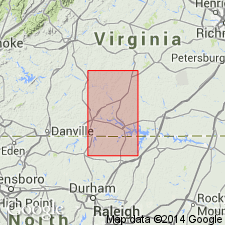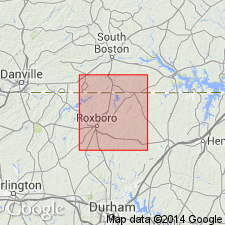
- Usage in publication:
-
- Hyco quartz porphyry
- Modifications:
-
- Named
- Dominant lithology:
-
- Schist
- AAPG geologic province:
-
- Piedmont-Blue Ridge province
Summary:
The acid volcanics of Virgilina district originally were rhyolite or quartz porphyry and rhyolitic tuffs, but in their present condition are largely sericite schists that may or may not show more than remnants of their original minerals and texture. In this report these rocks are described under name Hyco quartz porphyry. The formation consists largely of quartz-sericite schist, which represents a mashed and otherwise metamorphosed quartz porphyry or rhyolite, and which was tuffaceous in certain areas. It appears to be oldest of the volcanic rocks, at least its areal distribution indicates that it underlies the other volcanics. In southeastern part of Virgilina district, its place is apparently taken by Goshen schist. Underlies Aaron slate. Assigned to Ordovician(?).
Source: GNU records (USGS DDS-6; Reston GNULEX).

- Usage in publication:
-
- Hyco Formation*
- Modifications:
-
- Overview
- Dominant lithology:
-
- Pyroclastics
- Schist
- Greenstone
- AAPG geologic province:
-
- Piedmont-Blue Ridge province
Summary:
Hyco Formation used in accordance with Harris and Glover (1988). Consists of rhyodacitic to andesitic pyroclastic rocks now largely altered to quartz-feldspar-sericite schists and tuffaceous greenstone. Altered to kyanite quartzite in vicinity of Hagers Mountain, Person Co., NC. Age is Late Proterozoic.
Source: GNU records (USGS DDS-6; Reston GNULEX).

- Usage in publication:
-
- Hyco Formation
- Modifications:
-
- Overview
- Geochronologic dating
- AAPG geologic province:
-
- Piedmont-Blue Ridge province
Summary:
Includes light-gray, fine- to medium-grained, foliated quartz-muscovite schist with relict quartz and plagioclase phenocrysts; lithic and crystal metatuff with relict volcanic fragments; and, minor felsic breccia and tuffaceous greenstone. Underlies Aaron slate. Hyco has been dated at 620+/-20 Ma (Pb-Pb zircon, Glover and others, 1971).
Source: GNU records (USGS DDS-6; Reston GNULEX).
For more information, please contact Nancy Stamm, Geologic Names Committee Secretary.
Asterisk (*) indicates published by U.S. Geological Survey authors.
"No current usage" (†) implies that a name has been abandoned or has fallen into disuse. Former usage and, if known, replacement name given in parentheses ( ).
Slash (/) indicates name conflicts with nomenclatural guidelines (CSN, 1933; ACSN, 1961, 1970; NACSN, 1983, 2005, 2021). May be explained within brackets ([ ]).

